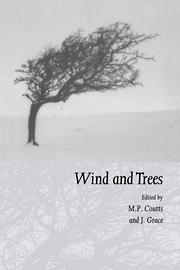Book contents
- Frontmatter
- Contents
- Preface
- List of contributors
- Part I Airflow over topography and in forests
- Part II Mechanics of trees under wind loading
- Part III Tree physiological responses
- 14 Wind-induced physiological and developmental responses in trees
- 15 Responses of young trees to wind: effects on root growth
- 16 Wind stability factors in tree selection: distribution of biomass within root systems of Sitka spruce clones
- 17 Development of buttresses in rainforest trees: the influence of mechanical stress
- Part IV Impacts of wind on forests and ecology
- Part V Risk assessment and management response
- Index
14 - Wind-induced physiological and developmental responses in trees
Published online by Cambridge University Press: 27 October 2009
- Frontmatter
- Contents
- Preface
- List of contributors
- Part I Airflow over topography and in forests
- Part II Mechanics of trees under wind loading
- Part III Tree physiological responses
- 14 Wind-induced physiological and developmental responses in trees
- 15 Responses of young trees to wind: effects on root growth
- 16 Wind stability factors in tree selection: distribution of biomass within root systems of Sitka spruce clones
- 17 Development of buttresses in rainforest trees: the influence of mechanical stress
- Part IV Impacts of wind on forests and ecology
- Part V Risk assessment and management response
- Index
Summary
Abstract
The influence of wind on tree growth and development is interpreted within the context of stress and strain relationships. The primary stress is the force of the wind applied to the tree. The fluttering of leaves and branches, the back and forth swaying motion of the stem, the displacement or wind-induced lean of the stem and failure of the stem or roots, resulting in windthrow, are the viable, mechanical strains manifest by the tree. Secondary stresses include the influence of gravity due to displacement, and changes in the atmospheric conditions around leaves. As the magnitude of the stress (windspeed) increases, so do the resulting strains, resulting in a cascade of physiological strain responses. The physiological responses range from rapid changes in transpiration and photosynthesis at the foliar level, to reduced translocation, callose formation and ethylene production in the phloem and cambial zone. Long-term developmental and structural changes occur in canopy architecture, leaf, stem and root morphology, and modifications of cell structure and biomechanical properties of the xylem. The interaction between acute and chronic wind stress, and dynamic and static loading stresses, with their influence on physiology and development is discussed.
Introduction
Since Metzger (1893) first proposed wind as the most significant or ‘Massgebender’ factor affecting growth of trees, the literature on wind stress has been intertwined within the fields of ecology, physiology and forestry. The ecological literature has focused on canopy and leaf responses, originally interpreting wind-formed trees as a pathological condition of induced nutrient and dehydration stress (assumed as increased transpiration), leading to mechanical damage (Schimper, 1903; Shreve, 1914; Daubenmire, 1959; Odum, 1970; Weaver et al, 1973).
- Type
- Chapter
- Information
- Wind and Trees , pp. 237 - 263Publisher: Cambridge University PressPrint publication year: 1995
- 110
- Cited by

